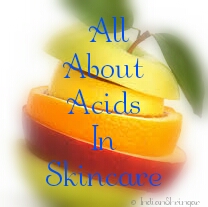A for Alpha Hydroxy Acid
B for Beta Hydroxy Acid
H for Hyaluronic Acid
R for Retinoic Acid….
Anyone with even the slightest interest in skincare would be aware of the importance of AHAs (Alpha Hydroxy Acid) and BHAs (Beta Hydroxy Acid) in maintaining healthy, youthful and acne-free skin. If you aren’t aware of them, well then this post is just for you. Besides these, there are certain other acids like Hyaluronic Acid and Retinoic Acid too that play a crucial role in skincare.
My first experience with any form of acid in a skincare product was during my teens when I used an anti-acne facewash with Salicylic Acid. From there, my knowledge expanded to Lactic Acid and then Glycolic when my cousin started getting peels done for his acne. As I became more interested in skincare, especially anti-aging, I realised that there were many more acids, each of which works in different ways but all help in the quest of healthy, radiant skin. Read on to know more about them….
Alpha Hydroxy Acids
Alpha Hydroxy Acids, or AHA for short, are acids that are derived from fruits. One if them is also derived from milk. These acids help in cell turnover and skin rejuvenation and thus aid in lightening acne spots and pigmentation. They also help in gently exfoliating the dead skin cells and for these reasons, they are used in the various “chemical peels” offered by the dermatologists. They also make the skin more photo-sensitive and susceptible to sun damage so use them prudently and ALWAYS wear adequate sunscreen. These are the most popular AHAs used in skincare :
Citric Acid
Found in abundance in citrus fruits such as lines, lemons, oranges and kiwis, Citric Acid helps in brightening the skin and lightening spots. However, not all skin types can handle Citric Acid and excessive it improper usage can cause skin to become red, raw, sensitive and start peeling.
Glycolic Acid
Naturally occurring in sugarcane, this is one of the most popular AHAs. Glycolic peels anyone? It brightens skin, helps in controlling acne, reduces hyperpigmentation and also reduces flakiness. It can be used by almost all skin types. I have used the Mario Badescu Glycolic Acid toner and the Blithe Water Patting Pack (used as a toner, detailed post soon) and both have worked very well for me.
Lactic Acid
Lactic Acid is generally derived from milk and other dairy products though it is also found in fermented fruits and veggies. This is probably the gentlest of all the AHAs and hence can be used even by those who have sensitive skin. Useful in anti-aging as well as in aiding dry skin retain moisture. That’s why all those soap and body lotion ads mention “milk cream or milk” being among the ingredients.
Malic Acid

Most commonly found in apples and cherries, Malic Acid is also found in small quantities in other fruits and vegetables as well. This Acid too, helps in reducing the build up of dead skin cells, brightens skin, smoothens the texture and also stimulates collagen production!
Mandelic Acid
Found in bitter almonds, Mandelic Acid too, is gentler than the other AHAs (perhaps not as gentle as Lactic, though) and hence is a safer option for sensitive skin battling with acne, pigmentation and even aging.
Tartaric Acid

Grapes, and wine too, are a huge source of Tartaric Acid, which, like the other AHAs is useful in cell turnover, skin brightening and anti-aging. However, since it isn’t as stable as the others, it isn’t very commonly used in skincare products.
Beta Hydroxy Acid
Unlike the multitude of AHAs, there’s just one Beta Hydroxy Acid or BHA and that is Salicylic Acid. Anyone who has faced acne would know how effective Salicylic Acid is in acne control. One of my favourite anti-acne face wash, the Vichy Normaderm Cleansing Gel features this Acid in it’s ingredient as well almost any other product targeting acne.
Unlike most AHAs, BHA (Salicylic Acid) is oil soluble which means that it can penetrate sebum-filled pores to effectively clean and exfoliate them. Besides this, it is also anti-bacterial and anti-inflammatory making it a wonderful product for oily / combination and acne-prone skin.
Besides the AHA and BHA, there’s another Acid that is in the ingredient list of Vichy Normaderm cleanser and that is LHA. I haven’t come across many products worth this Acid but since it is an acid and since this post is on acids in skincare, I did some research on it.
Lipo Hydroxy Acid
LHA, or Lipo Hydroxy Acid works in a similar way to Salicylic Acid. It has an anti-microbial, anti-inflammatory and anti-fungal properties and hence is used to treat acne and sometimes even dandruff. Probably the best part about LHA is that it has a pH of 5.5 which is the same as that of normal skin making it easier to use and combine with other skincare products.
Hyaluronic Acid
I have been loving products with Hyaluronic Acid (read this and this) because of the way they infuse moisture into my dehydrated skin. Hyaluronic Acid gives skin it’s plumpness and smoothness by holding onto water. As we age, the natural Hyaluronic Acid levels in our skin slowly decline. Products with Hyaluronic Acid help to hydrate skin and keep it moist and supple while also increasing volume and thus, reducing the appearance of fine lines and wrinkles.
Retinoic Acid / Tretinoin
Retinoic Acid is a metabolite of Vitamin A (also known as retinol) that mediates the functions of vitamin A required for growth and development. In skincare, this ingredient works by increasing the rate of cell turnover, preventing the breakdown of collagen, and thickening the lower layers of skin where the wrinkles actually start forming. Retinoids also help to get rid of dark spots and pigmentation by sloughing off the dead skin cells and also controlling melanin production!
There are various kinds of retinols and of differing strengths and ideally should be used on the prescription of a dermatologist. Most over the counter skincare products containing any Retinoid would have it in a mild strength making it safe to use. However, with Retinoids, skin reddening, peeling and dryness are to be expected as well as a bit of photo sensitivity.
So, that was a quick lesson on acids in skincare. As for how to use these acids…. Besides settings and moisturisers and dermatological peels, the best way to incorporate AHAs in your skincare routine would be through an acid toner. While there are barely any available in India (Clarins had an exfoliating toner), there are several options available internationally. However, less is more with acids and you have to start off with just twice or thrice weekly usage. Do not go overboard with these since they can over-exfoliate your skin and make it sensitive, red and peeling. And of course, using a sunscreen is mandatory.
I do hope that you have found this post helpful. Do let me know your queries in the comments below.








Hi Dollie ,
I always watch your video and also read your blogs ,and also I follow many on Instagram too…
As I am in the age of 30 I too face many problems like other women do
While reading blogs I came across your routine. In which the brands are are not pocket friendly, for many people.
I would like to request you can please make the one blog and vlog seperately for the pocket friendly acid face wash,creams etc..
I will be very grateful to you
Thanks in advance.
Hey, some of the products that I have reviewed, like the just herbs or Dr Sheth’s ones, are quite affordable. In skincare, some of the “affordable” products have quite a few nasty ingredients. I will surely try and feature more affordable brands henceforth.
very informative post Dollie….I always wondered what are those…never really bothered to check online about it….This post really helps understand the ingredients in the skincare pdts and help choose them according to the specific skin concern.There are a lot of ppl who ask me..whether some specific skincare pdt like some thign which has retinol, hydroxy or glycolic acid..is it safe to be used for pregnant woman….I somehow clearly don’t know the answer…
I’m glad this post helped Renji.
Pregnant women should ideally restrict the usage of retinol except under doctor’s guidance. Glycolic and Hyaluronic wouldn’t really be an issue but it’s always better to consult the doc before doing anything when ur pregnant.